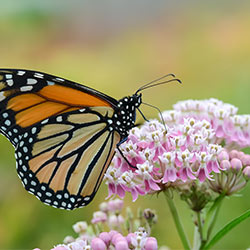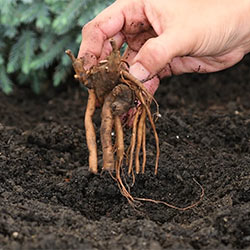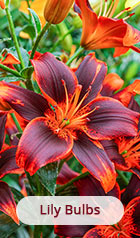
Butterfly Flowers
Butterfly Flowers, also known as ornamental milkweed, butterfly weed, or Pleurisy root, are part of the milkweed family, Asclepias. These plants earn their nicknames through bright, clustered flowers and tendency to attract butterflies and hummingbirds. In terms of plants for attracting butterflies, these are among the absolute best.
Butterfly Flower Quick Facts
Botanical Name:
Asclepias
Most Popular Colors:
Asclepias, or butterfly plants, bloom in a variety of warm colors including
orange,
yellow, violet and red.
Blooming Season:
Butterfly weed will typically bloom in summer.
Soil Preferences:
Butterfly flowers grow best in loamy, well-drained soil. Many varieties of butterfly flowers prefer soil amended with sand or hummus for drainage.
Climate Preferences:
Butterfly flowers require a period of cold to blossom, and prefer regions with seasonal weather changes.
Sun Exposure:
Butterfly flowers need partial shade to full sun. That generally means that these plants prefer at least four to six hours of sunlight per day-and they'll reward you with better blooms if given plenty of sunlight.
Butterfly Flower Plant Care

Growing butterfly flowers is a great way to attract pollinators to your yard, including some of nature's most important workers. Monarchs are the plant's biggest fans, but many varieties of flutterers use these plants as a food source. Butterfly plants also make great cuttings and good patio plants.
Siting your butterfly flowers is relatively easy. Most varieties of butterfly flower are drought-tolerant and can be placed in your
garden's drier spots. Asclepias is native to North America, making it more tolerant of our soil and climate than non-native plants.
Butterfly flowers can't compete with other surface-rooted plants, including some
Trees & Shrubs, so don't plant them near overpowering plants. Plant the tubers vertically, 1 inch deep, spaced 15 to 18 inches apart. Top the tubers with light soil, amending your garden soil with compost or humus if necessary.
Butterfly flowers are relatively drought-tolerant after established, but make sure to allow only the top inch or two of soil to dry out during the first year. You can apply a light, balanced fertilizer in springtime. Butterfly flowers are a good candidate for granular fertilizer, or use liquid fertilizer as the plants begin to bloom.
After your butterfly plant is done flowering, you can trim off the faded flowers-deadheading can promote additional blooms-and enjoy the foliage through the end of the season. In spring, you can cut your butterfly weed all the way to the ground.
We've included some basic growing tips for butterfly flowers below:
-
Butterfly weeds grow quickly, with little maintenance required!
-
These plants prefer drier conditions, so water lightly.
-
Deadhead butterfly flowers after they are finished blooming to prolong the blooming season.
-
Butterfly plants are poisonous to some animals, so keep these out of the way of pets.
Butterfly Flowers Pests and Disease Prevention
While proper maintenance and care of your butterfly flower plant will help set it up for success, unfortunately, they are not immune to pests and diseases. Let's talk about some of the common issues and fixes for problems with butterfly flowers.
Oleander Aphids
Unfortunately, oleander aphids are a very common problem with butterfly flowers. These small insects with bright yellow color are easily identifiable when they begin to cluster around the leaves and stems of butterfly weed plants. To rid your plants of this pest, wearing gloves you can try carefully squishing the aphids. Another way is to knock them off with a strong spray of water every two or three days over a week. Avoid using insecticides or pesticides on your butterfly flowers, as this can be harmful to the monarch caterpillars and the presence of nitrogen will encourage the aphids to reproduce more quickly.
Spider Mites
Spider mites are minuscule pests that will appear on the leaves of your butterfly weed. If your butterfly flower plant is experiencing drought stress, this can make spider mites more likely to appear. Although the mites themselves are very hard to detect, their presence will be apparent from the blotchy appearance of your hibiscus leaves. The good news is that they are fairly easy to get rid of, all you need to do is spray them off with a hose.
Be sure to check out our
tips for foolproof gardening page for more information on achieving success in your garden!
Have another question? Return to the Customer Service Help page or send an e-mail directly to Customer Service























